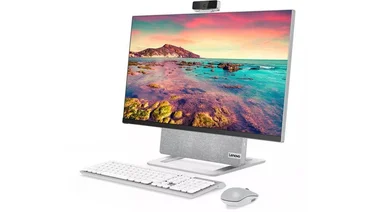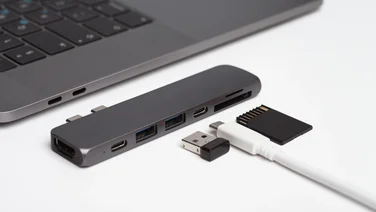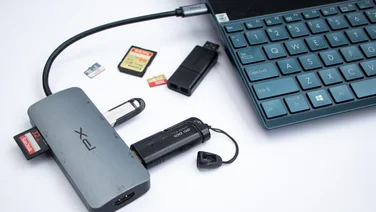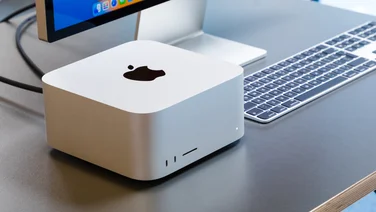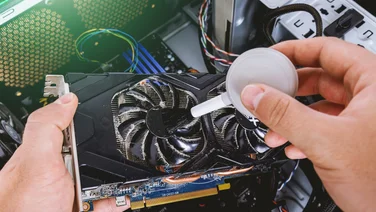To help us provide you with free impartial advice, we may earn a commission if you buy through links on our site. Learn more

- Powerful Kaby Lake CPU
- Nippy 250GB SSD
- Good upgrade potential
- No room for another 3.5in HDD
- No dedicated GPU
Palicomp’s impressive new i5 Titanium all-in-one PC shares a lot of similarities with our current favourite PC, the firm’s AMD Avenger. It’s the same price after all, and shares an identical ultra-compact Fractal Core 1100 chassis. Take a look inside, though, and these visually identical systems couldn’t be more different.
Most obviously, this is an Intel-based system rather than AMD-based, so instead of a cheap and cheerful Athlon X4 880K, you get a newer, more powerful Intel Core i5-7400. Despite the AMD chip’s higher clock speed (the i5-7400 runs each of its four cores at 3.0GHz, and can Turbo Boost up to 3.5GHz), the i5 Titanium outpaces the AMD Avenger by some pretty huge margins: it scored 108 in our image test, 103 in the video test, 87 in the multitasking test and 96 overall.
All four results represent big gains on the AMD Avenger, but special mention goes to its multitasking performance; the older PC scored 57 here, so the i5 Titanium has a much better time when you’re running multiple applications at once. The memory is also a big help in this regard: the i5 Titanium’s 8GB of DDR4 RAM is clocked at a relatively nippy 2,33MHz, and it’s split across two 4GB sticks in dual channel mode. This doesn’t make a huge difference, but it does allow for memory actions to be performed in parallel, which is slightly quicker than having them all on a single channel.
Palicomp i5 Titanium review: Performance
The i5 Titanium doesn’t have a dedicated GPU, like the AMD Avenger’s RX 460 (originally a GeForce GTX 960 when reviewed), although this is of course by design – this is meant to be a home office PC, after all, hence why Palicomp has wisely invested more in CPU power instead. Nonetheless, the Core i5-7400 surprised us in our Dirt: Showdown benchmark, where it achieved a 40fps average – that’s slightly higher than the other PCs we’ve tested that use the same integrated Intel HD Graphics 630.

It’s also worth noting that, while the Core i5-7400 sounds like an inferior choice to Core i5-7500, the former holds its own very well. Compared to the Mesh Home PC – CS, for example – the i5 Titanium is only a trivial three points behind in the image-editing test and just one point behind in the video-editing test. It’s only multitasking where you might actually see a difference in practice, and only then during the most highly intensive loads.
One final benefit to using this Kaby Lake processor is that it comes with Intel’s low-profile air cooler. This makes it much, much quieter than the AMD Avenger when the going gets tough, and while there’s no exhaust fan (there is a 120mm intake fan at the front, but it’s generally ideal to have one at the back as well, nearer those heat-producing motherboard components), the system never seemed remotely in danger of getting too toasty, or even particularly warm.
It’s not just the CPU that performs well, either. The 250GB SSD, an SK Hynix 301, measured up admirably in the AS SSD benchmark, with a sequential read speed of 516.54MB/sec and a sequential write speed of 424.84MB/sec. The capacity – 250GB – is good for a desktop SSD, provided there’s a larger drive backing it up, and that’s exactly what the i5 Titanium has too: a 1TB WD Blue hard disk.
Palicomp i5 Titanium review: Expansion
One slight shame is that you can’t add any more SATA-based storage drives. The Fractal Core 1100 uses a vertical drive mount instead of a stacking cage, and this can only take either three 2.5in drives, two 3.5in drives, or one of each (the configuration we have here). Thus, if you ever find yourself filling that 1TB HDD to the brim, you’ll need to replace the whole drive with a larger model instead of just adding another beside it.
Fortunately, you have a few more options at the higher-end, thanks to the Asus Prime B250M-A motherboard’s dual M.2 slots. These will allow you to upgrade your storage with even faster NVMe drives, and while there’s no RAID capability, the up-to-date chipset and Kaby Lake processor do allow for the use of Intel Optane drives as well – so if adding capacity isn’t a concern, you can theoretically make the SL 301, and thus the entire system, even faster.
For a micro-ATX motherboard, the Prime B250M-A is remarkably well equipped in general. In addition to those two M.2 slots and a fairly standard one PCIex16/two PCIe x1 expansion card setup, there are a full four RAM slots, an area where some small boards skimp to two. It also offers up a fiddle-free USB Type-C port on the back panel, plus a handy HDMI port in addition to the DVI-D and VGA outputs.

Palicomp i5 Titanium review: Connectivity
There’s only a bare minimum of full-sized USB ports – two USB 2s and two USB 3s at the back, with two USB 3s at the front – and just the usual line in, line out and microphone audio jacks, plus Ethernet and two legacy PS/2 ports. We were pleased to see a DVD R/W drive included, though; with this, you can rip old CDs, watch DVDs or create backup disks without the faff of an external drive. This only takes up one of the two 5.25in drive bays, so there’s leeway to add upgrades here as well.

Palicomp i5 Titanium review: Verdict
What Palicomp’s i5 Titanium lacks in single, killer features, it makes up for by being strong in just about every area. As such, minor, arguably situational disadvantages like the lack of hard-disk upgradability aren’t nearly enough to stop it succeeding.

